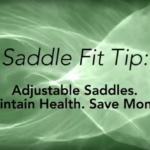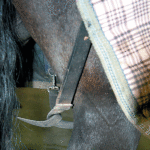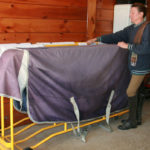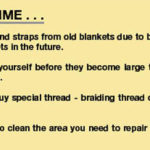We’re so much luckier than horsemen from a couple of generations ago. They had to deal with heavy turnout blankets that caused horses to sweat if the temperature went up just a few degrees and easily became water-logged in rain or snow and very heavy.
Today’s blankets are a delight in comparison. They’re easy to lift, water-resistant and breathable, so there’s no need to rush to the barn to get the blanket off when the sun comes out.
Sizing
Blanket sizes vary by style, cut and manufacturer. Plus, there could be a slight but significant difference among manufacturers in how you’re told to measure. Generally, you measure for a blanket from the center of chest to around the widest part of horse to tail.
The chest should close completely with some overlap of fabric to keep drafts out. Look for soft straps that buckle easily and have keepers. Many blankets now have Velcro at the chest area to keep things snug and make working the fastenings easier, a definite plus.
Horizontal straps and buckles are most common. Some, like the Union Hill Warlock, have a snap and buckle that give you adjustability and quick ease, which is great if you have a lot of horses to dress and undress.
A few have straps that cross diagonally, which allow the horse more freedom to lower his head. Be careful, though. We found the cross snaps on the JPC Stretch Manager may not be a good choice for young or busy minded horses. A test horse playing with them hooked them in her mouth like a bit and could not get free.
Neck Fit
Horses vary a great deal in neck and shoulder conformation. Many blankets offer a Velcro neck adjustment. While this wasn’t perfect, we found it did help reduce gaps.
The elastic neck of the Turtleneck is dandy, but it’s only available for higher necked horses. It’ll work well on Arabs, Morgans and other horses with similar conformation. Schneiders Saddlery’s Stormshield Vetek has a V insert at the withers that fit higher-withered horses well.
Blankets labeled as a ”Euro fit” are cut higher at the neck and hang longer on the body, usually with no back seam or hip darts. This increases overall coverage and uses fewer seams. We’ve found stitched areas are the first to allow water to seep in.
Almost all our test blankets had shoulder gussets, which is great, since shoulders are often a site for rubs. Flank gussets serve little purpose to us.
Surcingle
The surcingle, whether cross-straps or bellyband style, should be comfortably snug, not girth tight or draping loose. We like a bit of elastic in the surcingle, like on the Union Hill Warlock, to aid in comfort and fit.
Most blankets had T hooks on the surcingle straps, and some had added an O ring to help keep the hook secure. The rubber ones, such as the ones on the Rescue blanket worked great, but the hard plastic on the Kodiak was a frustration in the cold.
Leg straps should be neither tight nor hanging loose. The horse has to be able to move freely without the straps rubbing him raw. Elastic ones can be adjusted shorter and hooked to the same side of the blanket. Plain straps work better looser and crossed to the opposite side or passed around each other before hooking to either side of the blanket.
A nice addition is a fleece or satiny tube to cover the leg strap, especially if it isn’t elastic. For cleaning or layering, straps that are removable like Paint Rock Designs blanket are helpful (they even include extras).
For winter, we like a tail or storm flap, but it’s even better when it is removable for easy cleaning or nicer weather. It’s a dirty area.
Our trial was held in the Northeast, and winter through everything it had at our horses. Most of the blankets kept our horses comfortable in all but the pouring rain. Leakage in pouring rain varied from lower denier soaked through to leaks in stitched areas on higher denier covers. All the blankets in our trial were waterproof/water-resistant and breathable.
Note: A blanket marked ”waterproof” means that no water is supposed to be able to penetrate the material. A water-resistant blanket will ”resist” most light showers and snow storms but leakage may occur with heavier moisture.
The more grams of insulation, the warmer the blanket. Note that most blankets are not filled all the way down the sides, although the Turtleneck is. The Brookside offers a 340-gram fleece back liner instead of polyfill on a lighter turnout.
A few, like the Glover Five Star Elite, have an attached neck cover, added warmth and a great way to keep wetness from running down and in around the shoulders. One test horse loved it, but two others were bothered by being so enclosed.
”Breathable” is the big word in blankets for good reason. As the temperatures yo-yoed as much as 30 degrees, the horses stayed comfortable with no sign of sweating. Even the heavyweight blankets at above-freezing temperatures showed only minimal sweat spots starting to develop.
Your horse’s lifestyle is an important determining factor in blanket selection. If he spends most of his time in a stall he isn’t likely to need more than a medium-weight winter blanket unless he’s kept clipped. A pasture horse with a run-in shed may be happier with a midweight, unless you are in a particularly frigid area (then you’ll reach for JT International’s 500 gram insulation). Naturally, keep in mind the horse’s age and condition, as these factors will limit his ability to stay cozy then opt for a warmer blanket.
Another consideration is your horse’s companions. Does he romp with playful buddies’ Horse teeth can be tough on a blanket, and higher denier will take the abuse better. The Rambo blanket and the Brookside are among those that we think will hold up best in rough crowds.
Another good choice for rougher environments is the Stormshield VTEK Marathon, which survived a horse who thought it was his magic suit of armor for pushing through fences.
Consider the cost of cleaning and repair in comparison to buying a new blanket each year. If your horse should have been named ”El Destructo” you might be ahead of the game to get a cheaper blanket and replace it each year rather than an expensive one you want to last for years.
Bottom Line
Horse teeth can be tough on a blanket, and we found that the toughest exteriors were on the Tough-1 Pola r 1680 denier, the Brookside Medium Weight Turnout and Stormshield VTEK Marathon, which survived a horse who thought it was a suit of armor for pushing through fences.
For a lightweight waterproof choice, we found the Weatherbeeta Orion Freestyle a great choice.
For overall top pick, we had three contenders. The Ice Turtle Turnout from Paint Rock Designs is an incredible blanket, and we can’t imagine what could be improved, although Quarter Horse owners are out of luck on this one. For these horses (and others, of course), we like the Glover Five Star Elite. Both these blankets, however, are over $250 each and won’t fit in some budgets.
With that in mind, we give the No. 1 nod to the JT International Tough-1 Polar 1680. At $139.80, we found a tough, nicely fitting, warm blanket that kept our horses dry.
Our Best Buy blanket choice is the $99.95 JPC Equestrian Rescue blanket. It’s a medium-weight blanket that fits nicely without leaks and stays put.
Horse Journal staff report.







